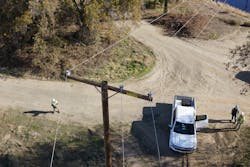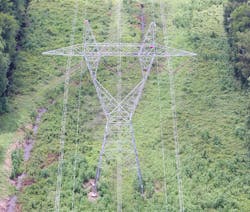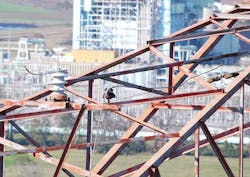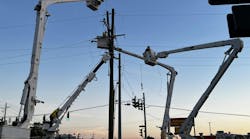Many utilities are discovering the benefits of leveraging unmanned aerial vehicles (UAV). UAVs are a game-changing solution for utility infrastructure inspections and disaster management. also known as drones, UAV’s reduce the need for manual inspections in hazardous environments, such as high-voltage power lines, remote substations, or other critical infrastructure assets, minimizing the risks associated with human exposure to unsafe conditions.
Based on my company’s recent experience, receiving first-in-industry FAA certificate of authorization for utility powerline inspection flights beyond visual line of sight (BVLOS), this article, offers electric utility drone pilots a wholistic approach to a UAV program.
Adhering to Detailed Operating Procedures
When it comes to UAVs, implementing and adhering to key operating procedures is essential to ensure safe and efficient operations. These types of operational procedures meeting manned aviation standards are also appropriate for unmanned technologies and capabilities.
Pre-Flight Planning and Preparation: Before each flight, operators must develop a detailed flight plan with consideration to weather conditions, airspace restrictions, terrain, obstacles, and human factors. While planning, they conduct a thorough risk assessment to identify potential hazards and appropriate mitigation strategies along with contingency plans for emergencies or unexpected situations.
Airspace Regulations and Compliance: The FAA mandates that UAV operators must be knowledgeable about airspace classifications, airspace restrictions, and the specific rules and regulations associated with operating UAVs to mitigate the risk of unauthorized operations and/or potential airspace violations. This knowledge is vital for UAV operators performing inspections in sensitive areas where utility infrastructure may be located and includes avoiding restricted areas and obtaining any necessary waivers or permissions. The standard to ensure compliance is through a robust training program.
Remote Pilot Certification and Compliance: In the U.S., operators must pass the FAA Part 107 exam which tests knowledge of aviation rules and regulations, airspace, and other important topics. Operators must also comply with ongoing requirements such as registering UAVs, adhering to maintenance schedules, and keeping up with training and knowledge.
Pre-Flight Inspection: Comprehensive pre-flight inspections ensure that UAVs are in optimal condition during operations. Operators calibrate all necessary equipment to reduce the risk of mechanical failures. This includes checking the UAV's airframe, propulsion system, sensors, batteries, and other critical components to ensure that they are in proper working order. Any signs of damage or malfunction are addressed before initiating flight operations.
Real-time Monitoring and Situational Awareness: Throughout the operation, operators maintain real-time monitoring of the UAV's flight parameters, sensors, and surrounding environment including situational awareness of the UAV's position, altitude, speed, battery life, and other important metrics. Operators remain vigilant for any changes in environmental conditions and adjust accordingly.
Post-Flight Procedures and Data Management: After completing each flight, operators ensure proper shutdown of the UAV and data transfer. Data collected during the inspection process is managed in accordance with established protocols, including data analysis, storage, and reporting.
Complying with Operator’s Manual Regulations and Guidelines
Compliance with safety regulations is a top priority in both the utility and aviation industries. A comprehensive operator's manual serves as a crucial reference guide that outlines the operational procedures, safety protocols, and best practices for UAV operations—and provides comprehensive guidance on the operation of the UAV, including flight controls, sensor operation, data acquisition, and other critical functions. It helps operators understand the capabilities and limitations of the UAV and ensures that they are proficient in operating the UAV safely and effectively.
Standardization of Operations: By following consistent protocols, operators minimize the risk of errors or deviations from established safety practices—and ensure safe and efficient UAV operations, especially in complex environments such as infrastructure inspections and storm restoration efforts.
Emergency Response: An operator's manual, and associated training, includes procedures for emergency situations, such as equipment malfunction, lost communication, adverse weather conditions, or other unforeseen events during flight. It provides step-by-step instructions on how to respond to emergencies, including contingency planning, risk mitigation, and proper handling of emergency situations. Having a well-documented emergency response plan in the operator's manual is vital for emergency preparedness, minimizing the impact, and ensuring the safe recovery of the UAV.
Continuous Training and Knowledge Building
UAVs are sophisticated machines that can operate at considerable heights and in challenging environments. Without proper training, operators may lack the necessary skills and knowledge to operate UAVs safely, increasing the risk of accidents, damage to property or equipment, and potential harm to personnel. Training programs that cover topics such as flight regulations, risk assessment, emergency procedures, and operational best practices are essential to ensure that UAV operators are competent and capable of conducting inspections safely.
The accuracy and reliability of infrastructure inspections, maintenance planning, asset management, and damage assessments heavily rely on the skills of the UAV operator. A well-trained operator can efficiently navigate UAVs to capture high-quality images, videos, and data. An untrained operator may struggle with flight control, camera operation, and data collection, resulting in subpar results that may compromise the integrity of the inspection process.
Training also plays a crucial role in complying with regulatory requirements. The utility industry is subject to various regulations and standards, including those related to aviation, data privacy, and environmental protection. UAV operators need to be well-versed in these regulations and follow them diligently to avoid legal and financial liabilities.
Investing in proper training for UAV operators can yield significant returns on investment. Skilled operators can maximize the capabilities of UAVs, enabling them to perform inspections more efficiently and effectively. This can result in improved inspection accuracy, reduced inspection time, and optimized resource allocation, all of which contribute to cost savings and operational efficiencies. Additionally, well-trained operators are more likely to identify potential issues, assess risks, and make informed decisions during inspections, mitigating the likelihood of costly errors or mistakes.
Conducting Routine Maintenance
UAVs are complex systems that require routine maintenance to ensure their performance, safety, and longevity. Many regulatory bodies, such as the FAA, require UAV operators to comply with maintenance and inspection requirements to ensure safe operation and avoid any potential legal or regulatory issues that may arise.
Regular maintenance helps to ensure that all components of the UAV, including propulsion, avionics, flight controls, sensors, and communication systems, are functioning properly.
Identifying and addressing any potential issues in a timely manner minimizes the risk of accidents, incidents, or operational disruptions due to equipment failure during UAV operations and protects the safety of operators, other personnel, and the surrounding environment.
Addressing issues from the onset also prevents them from escalating into more costly repairs, reduces the need for frequent replacements, and can help prolong the lifespan of UAV systems thereby lowering overall operational costs. Well-maintained UAVs are also less likely to encounter unexpected operational disruptions, minimizing downtime, and potential revenue losses.
Having a well-established and documented maintenance program showcases a professional commitment to safety, reliability, and compliance with regulations.
Fostering a Strong Safety Culture
Safety culture encompasses the attitudes, behaviors, and values that shape an organization's approach to safety. As the utility industry continues to adopt UAVs, the importance of fostering a strong safety culture in alignment with utility safety goals cannot be overstated.
Instilling a "safety first" mindset among all UAV personnel emphasizes the importance of prioritizing safety over other considerations, such as productivity or deadlines. This mindset also promotes a proactive approach to identifying and addressing potential safety risks, minimizing the likelihood of accidents or incidents. It ensures that safety is embedded in every aspect of UAV operations, from pre-flight checks to flight operations to post-flight activities helping operators to make informed decisions.
Taking its lead from FAA safety, a UAV safety culture fosters a culture of open communication and reporting. It encourages personnel to report any safety concerns, incidents, or near-misses without fear of reprisal. This enables timely identification and resolution of safety issues, prevents recurrence, and promotes a culture of accountability and improvement. Open communication and reporting channels ensure that potential safety risks are addressed promptly, reducing the likelihood of incidents or accidents.
Adhering to Safe and Reliable Data Collection Protocols
UAVs are equipped with advanced sensor technology that enables precise and accurate data collection. High-resolution cameras, LiDAR, thermal imaging, and other sensors can capture data with exceptional detail, providing valuable insights into the condition of utility assets.
As the utility industry continues to adopt UAVs for critical infrastructure inspections, it's natural to have concerns about data collection. Data privacy, security, and integrity are critical considerations in today's digital landscape.
UAV operators adhere to strict protocols—storage, encryption, and data transmission via secure communication channels—to protect sensitive information collected during the inspection process and ensure compliance with relevant data protection regulations and laws. This ensures that data is protected from unauthorized access and tampering during transmission and storage.
UAV operators have robust cybersecurity protocols in place, including regular software updates, password protection, and encryption, to safeguard against potential data breaches. Professional UAV partners work closely with utilities to establish clear data usage policies and obtain necessary permissions for data collection. This includes obtaining consent from landowners or other stakeholders when conducting inspections on private property. UAV operators can also provide detailed reports on data collection processes, including flight logs, sensor calibration, and quality assurance measures, to ensure transparency and accountability.
Will Paden is the President of Soaring Eagle Technologies, and a pilot and instructor for UH-60 Blackhawk helicopters for the MS Army National Guard. Soaring Eagle is a technology-enabled unmanned aircraft systems drone inspections company, serving the utility industry nationwide. In 2015, Paden founded Soaring Eagle Imaging, an aerial imaging and GIS company. In 2021 the company united with Skynetwest to become Soaring Eagle Technologies, which is owned and operated by Houston-based Iapetus Holdings LLC. Paden is a graduate of Mississippi State University and since 2010 has been conducting UMV missions with a focus on safety.





